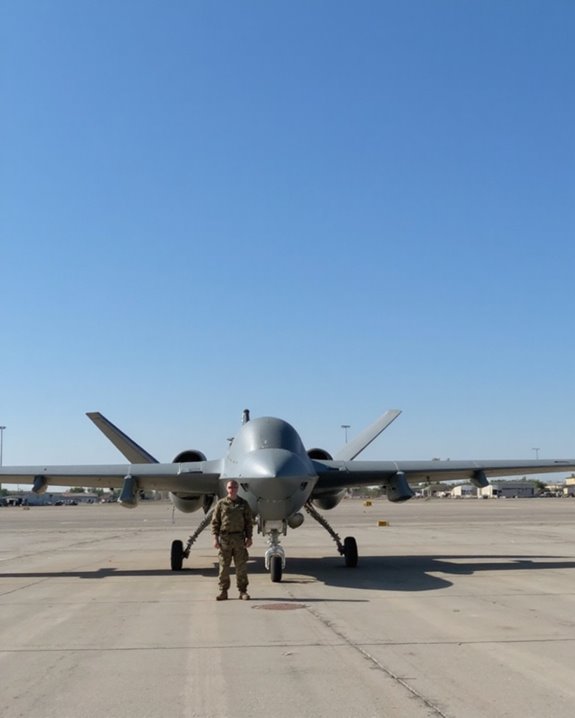Spotting a drone-laying queen means looking for trouble signs—like patchy, bumpy brood with mostly domed, “pencil eraser” drone cells poking out, all scattered across frames! Eggs seem thrown in willy-nilly, the queen’s laying is wild, and worker brood is scarce or missing. See lots of large cells, hardly any flat, dark worker brood caps, and a weak, shrinking workforce? Flip frames to check for the queen herself—she may look normal, but she’s causing chaos. Want advice on handling this royal mess? Keep going!
Key Takeaways
- Look for irregular brood patterns and an overabundance of drone brood, especially in the worker brood area.
- Check for eggs placed haphazardly in cells, often not centered at the cell base.
- Identify patches of raised, domed caps indicating drone brood scattered throughout the hive.
- Inspect for the absence of worker eggs and a dwindling worker bee population.
- Locate the queen and compare her appearance; she may look normal but is laying only drone eggs.
Recognizing the Signs of a Drone-Laying Queen
Spotting the signs of a drone-laying queen can feel like searching for a tiny, elusive celebrity in a crowd of lookalikes! To recognize this unusual queen, beekeepers should look for an overabundance of drone brood—those capped cells bulging from the comb—and a lack of worker eggs. Sometimes, the queen is nowhere to be found, but don’t jump to conclusions; a drone-laying queen often hides in plain sight, shaped by Queen Nutrition and Genetic Factors that can disrupt her egg-laying. Poor brood patterns, dwindling nurse bees, and no signs of swarming also raise red flags. If most cells hold drone brood and the queen seems absent, it’s not just bad luck—it could be the result of poor genetics or inadequate nutrition earlier in her life!
Differentiating Drone Brood From Worker Brood
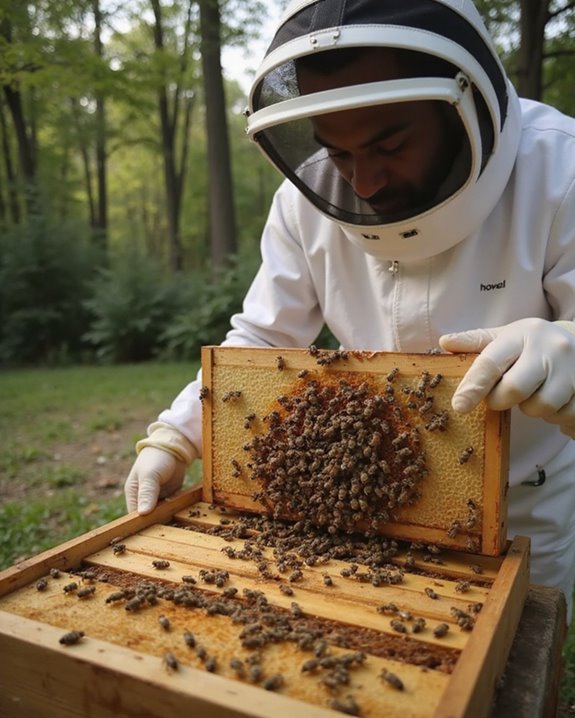
Once those telltale signs of a drone-laying queen start showing up, the real detective work begins—figuring out exactly what kind of brood is filling up those cells! Here’s where brood size and cap texture become your best friends. Drone brood cells are easy to spot if you know what to look for: they’re larger and deeper, measuring about 6.5 mm across, and the capped cells poke out like little pencil erasers. Check the cap texture—it’s lighter and domed, unlike the flatter, darker caps on worker brood. Sometimes, you’ll see whole patches of these raised caps, often set apart from the compact, darker worker brood clusters. If you squint, it almost looks like little hills popping up in the comb landscape!
Observing Brood Patterns for Clues

How does a beekeeper really know when something’s off in the brood nest? It all starts with the brood pattern! Spotty, uneven patches, or bumpy and raised cells—those aren’t just seasonal variations or the hive’s new interior decorating. Instead, they can signal a drone-laying queen, especially if you see mostly large drone cells scattered everywhere. Watch for patchy brood and a lack of worker eggs. Sometimes, even the best-fed colonies, with prime nutrient effects in play, can still show these signs if the queen is poorly mated or aging. Weak hives, less nectar and pollen storage, and irregular brood all point to trouble. Don’t wait—beekeepers who spot these patterns early can act before the colony’s woes get out of hand!
Physical and Behavioral Traits of a Drone-Laying Queen
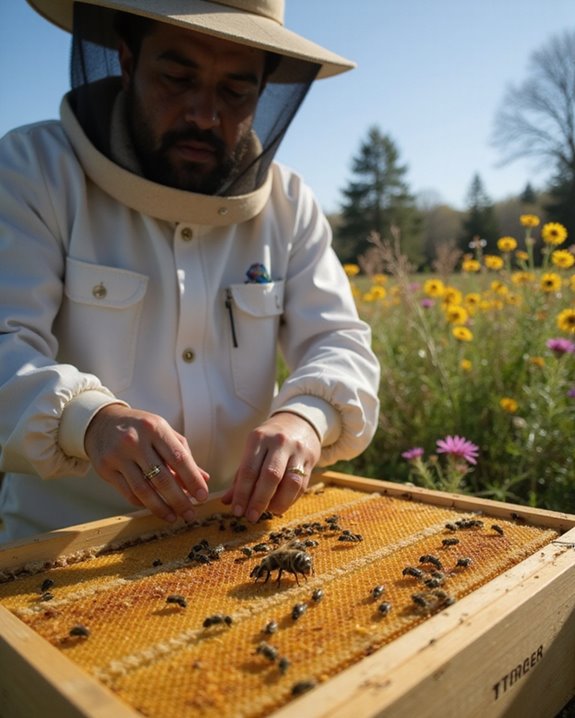
A drone-laying queen can be a mysterious figure in the hive, quietly changing the entire colony’s future without looking all that different from her healthy counterparts. Physically, she usually has a similar abdomen size, body shape, and even the same hairless back as a normal queen—no flashing neon signs here! Coloration rarely gives her away, either. Sometimes, she may look a bit smaller or less robust, hinting at underlying genetic factors or issues with Evolutionary Traits. Behaviorally, she’s busy laying eggs in the center of each cell, but these eggs all become drones. Workers often don’t even notice the switch, so the hive hums along, unaware of the trouble brewing. Over time, too many drones upset colony stability, impacting growth and honey reserves.
Distinguishing Between Laying Workers and a Drone-Laying Queen
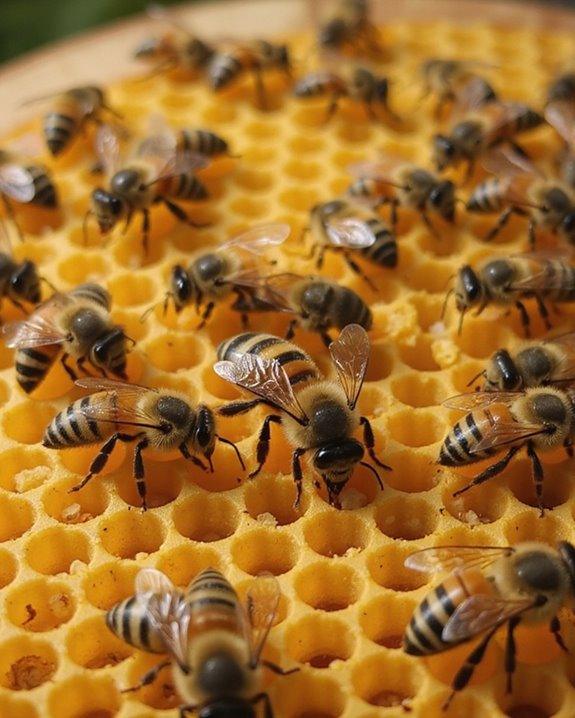
Surprisingly, telling the difference between laying workers and a drone-laying queen can feel like a real beekeeper’s detective story! Picture yourself peering into the hive, flashlight in hand, searching for clues. A drone-laying queen leaves a single egg in each cell, neatly placed, but all become drones. Laying workers, driven by nutritional effects and evolutionary factors, scatter multiple eggs in random patterns—even on cell walls! No worker brood is found, and the hive might act cranky, even rejecting a new queen. Pheromone influence is key: when brood pheromones drop, workers start laying, complicating matters. While a drone-laying queen can often be replaced, laying workers are tougher to manage. Both scenarios threaten colony survival, but their brood patterns and hive behavior tell the real tale!
Using Test Frames to Confirm Queen Issues
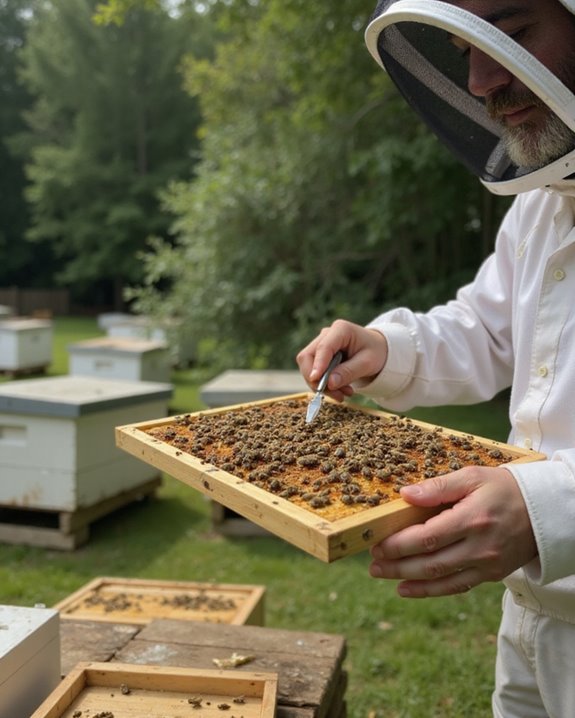
Ever wondered if your hive really has a queen or if the workers are just pretending to be in charge? Using a test frame is your secret detective tool. Place a frame with tiny larvae—not just eggs—into the suspect hive. Timing matters! Check back in three days, because queenless bees move quickly to build queen cells if they sense trouble. If you spot queen cells forming, you’ve confirmed queen issues. If not, don’t celebrate too soon; sometimes colonies need a second test frame, so keep a backup in frame storage, ready to go. Test timing is everything—wait too long, and you might miss the best clues. Remember, a strong, uniform brood on your test frame usually means your queen is still on the job!
Inspecting Frames for Brood Irregularities
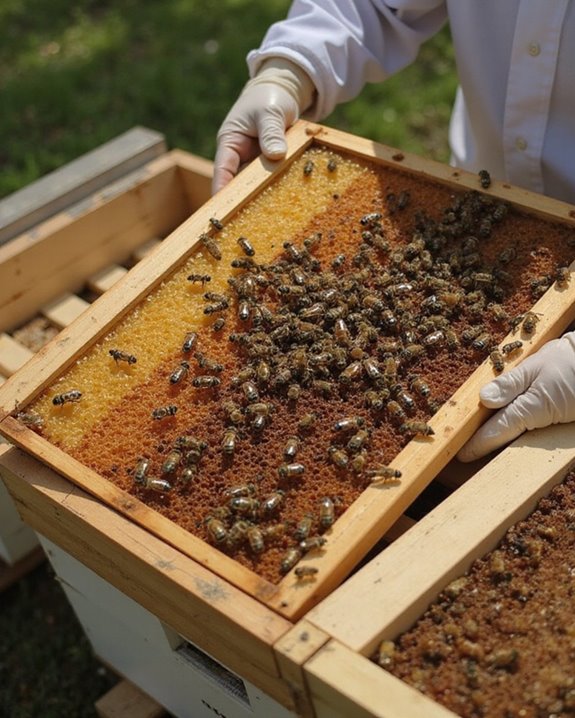
Once you’ve tried the test frame trick, it’s time to roll up your sleeves and really get to know what’s happening inside those hive boxes. Look at each frame closely—healthy brood should form a solid, “rainbow” pattern, with honey cappings up top, pollen beneath, and tight clusters of eggs, larvae, and capped brood below. If you notice spotty patches or lots of empty cells scattered around, that’s a big red flag for brood diseases or a failing queen. Pay special attention to cell cappings: smooth, slightly convex caps are good, but sunken or punctured cappings might signal trouble—like American foulbrood or viral infections. Don’t confuse food stores with brood; honey cappings look lighter! Careful inspection keeps you one step ahead.
Tools and Techniques for Accurate Identification
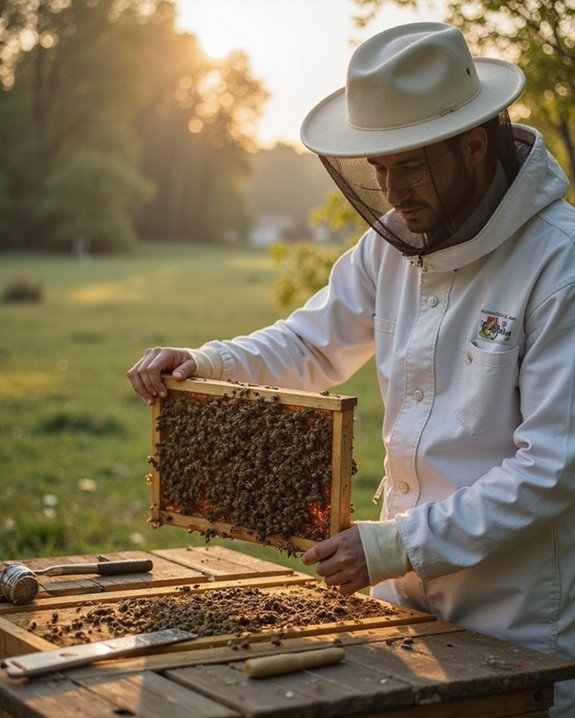
A well-stocked beekeeper’s toolkit makes all the difference when it comes to accurately identifying a drone-laying queen. Smokers—when properly maintained—calm the bees, offering you a friendlier inspection team and fewer dramatic exits! Protective gear innovations, like vented suits and flexible gloves, keep you sting-free and nimble as you handle frames. Bee brushes gently sweep away bees, while frame grips help you avoid the dreaded “oops” moment when a frame slips. A magnifying glass or hand lens is essential for spotting tiny clues, like drone brood in worker cells or irregular capping patterns. Combine these tools with sharp observation skills—watch for lots of drones or missing worker brood—and you’ll quickly spot trouble. Remember, regular smoker maintenance and updated gear innovations make every inspection smoother and safer.
Steps to Take When a Drone-Laying Queen Is Found
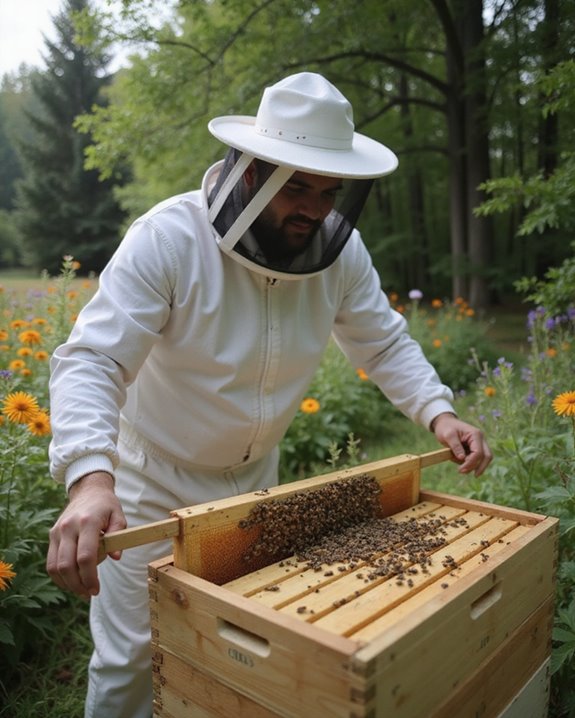
Spotting the telltale signs of a drone-laying queen—like lumpy, scattered brood patterns or frames packed with drone cells—can feel like catching the culprit red-handed! Once identified, it’s time for action. Start with brood removal: carefully pull out frames overloaded with drone brood, freeing up valuable space and resources. Next, confine the queen using a queen excluder or cage, keeping her from laying more drone eggs while you prepare for her replacement. Order a healthy, mated queen and have a queen introduction cage on hand. Before the queen introduction, make sure the colony is strong, with plenty of young bees ready to accept a new leader. Finally, after introducing the new queen, monitor closely for signs of acceptance—patience pays off!
Preventing Colony Decline Due to Drone-Laying Queens
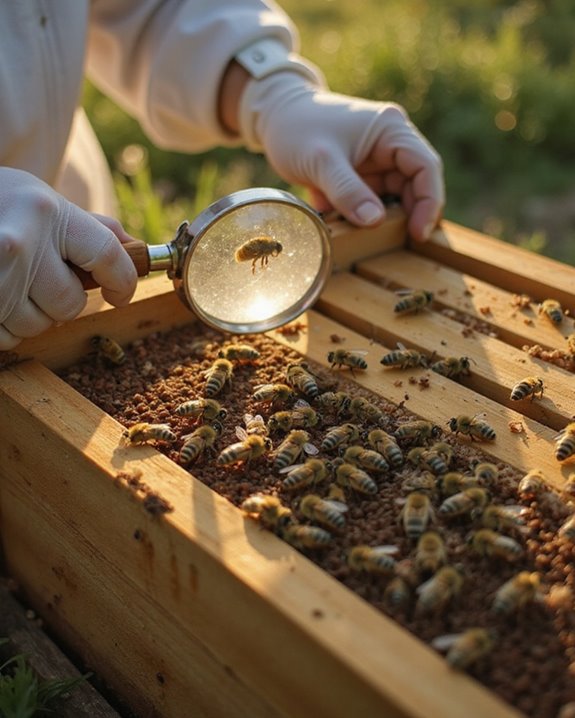
How can beekeepers keep their hives buzzing with life and avoid the heartbreak of colony collapse from a drone-laying queen? The key is regular hive inspections and a sharp eye for signs of trouble, like spotty brood patterns or sluggish bees. Mating success is essential—if your queen hasn’t mated well, she may only lay drone eggs, spelling doom for your worker population. Always have backup queens ready, either by maintaining extra colonies or sourcing from reputable breeders. Think of them as your hive’s emergency parachute! When you notice a failing queen, act quickly: replace her with a young, fertile queen who can restore order. Remember, attentive management and a little forward planning can keep your colony thriving—and your honey jars full!
Frequently Asked Questions
Can Environmental Factors Cause a Queen to Become Drone-Laying?
Environmental factors can contribute to a queen becoming drone-laying. Hive conditions, such as poor nutrition or stress, and weather influences like temperature fluctuations, can affect queen health, mating success, and egg fertilization, potentially resulting in drone-laying behavior.
How Does Queen Age Influence the Likelihood of Drone-Laying?
As Queen Aging advances, a subtle shift unfolds—her Drone Impact intensifies. Older queens, with diminishing pheromone levels and depleted sperm reserves, increasingly lay drone eggs, gradually tipping the colony’s balance and foreshadowing reproductive decline.
Is It Possible to Rehabilitate a Drone-Laying Queen?
Queen rehabilitation in cases of drone-laying is rarely successful, as reproductive limitations persist. Drone correction typically requires queen replacement rather than rehabilitation, since a failing queen cannot resume normal egg-laying and colony health continues to decline without intervention.
Can Genetics Play a Role in Drone-Laying Queen Occurrence?
The theory that hereditary factors influence drone-laying queen occurrence gains support through studies indicating DNA markers may predispose certain queens to reproductive issues. Genetic background, mating success, and inherited traits together shape the likelihood of drone-laying behavior.
Are Certain Bee Subspecies More Prone to Drone-Laying Queens?
Subspecies variations influence the likelihood of drone-laying queens, as bee adaptations differ across lineages. Certain honey bee subspecies, due to genetic predisposition or environmental resilience, may exhibit either increased susceptibility or resistance to drone-laying queen occurrences.



